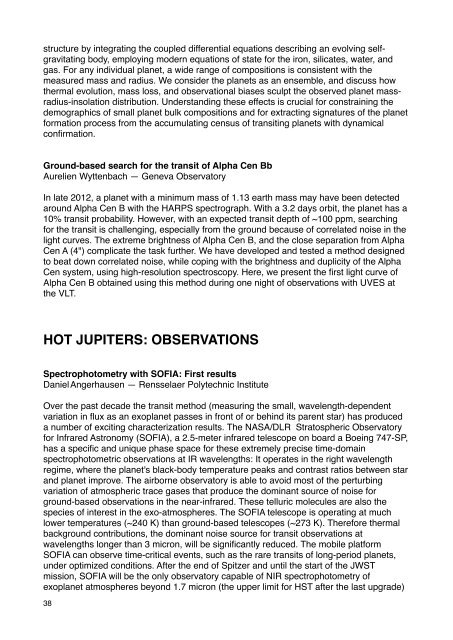Exoclimes_Conference_booklet1
Exoclimes_Conference_booklet1
Exoclimes_Conference_booklet1
Create successful ePaper yourself
Turn your PDF publications into a flip-book with our unique Google optimized e-Paper software.
structure by integrating the coupled differential equations describing an evolving selfgravitating<br />
body, employing modern equations of state for the iron, silicates, water, and<br />
gas. For any individual planet, a wide range of compositions is consistent with the<br />
measured mass and radius. We consider the planets as an ensemble, and discuss how<br />
thermal evolution, mass loss, and observational biases sculpt the observed planet massradius-insolation<br />
distribution. Understanding these effects is crucial for constraining the<br />
demographics of small planet bulk compositions and for extracting signatures of the planet<br />
formation process from the accumulating census of transiting planets with dynamical<br />
confirmation.<br />
Ground-based search for the transit of Alpha Cen Bb<br />
Aurelien Wyttenbach — Geneva Observatory<br />
In late 2012, a planet with a minimum mass of 1.13 earth mass may have been detected<br />
around Alpha Cen B with the HARPS spectrograph. With a 3.2 days orbit, the planet has a<br />
10% transit probability. However, with an expected transit depth of ~100 ppm, searching<br />
for the transit is challenging, especially from the ground because of correlated noise in the<br />
light curves. The extreme brightness of Alpha Cen B, and the close separation from Alpha<br />
Cen A (4") complicate the task further. We have developed and tested a method designed<br />
to beat down correlated noise, while coping with the brightness and duplicity of the Alpha<br />
Cen system, using high-resolution spectroscopy. Here, we present the first light curve of<br />
Alpha Cen B obtained using this method during one night of observations with UVES at<br />
the VLT.<br />
HOT JUPITERS: OBSERVATIONS<br />
Spectrophotometry with SOFIA: First results!<br />
Daniel!Angerhausen — Rensselaer Polytechnic Institute<br />
Over the past decade the transit method (measuring the small, wavelength-dependent<br />
variation in flux as an exoplanet passes in front of or behind its parent star) has produced<br />
a number of exciting characterization results. The NASA/DLR Stratospheric Observatory<br />
for Infrared Astronomy (SOFIA), a 2.5-meter infrared telescope on board a Boeing 747-SP,<br />
has a specific and unique phase space for these extremely precise time-domain<br />
spectrophotometric observations at IR wavelengths: It operates in the right wavelength<br />
regime, where the planet's black-body temperature peaks and contrast ratios between star<br />
and planet improve. The airborne observatory is able to avoid most of the perturbing<br />
variation of atmospheric trace gases that produce the dominant source of noise for<br />
ground-based observations in the near-infrared. These telluric molecules are also the<br />
species of interest in the exo-atmospheres. The SOFIA telescope is operating at much<br />
lower temperatures (~240 K) than ground-based telescopes (~273 K). Therefore thermal<br />
background contributions, the dominant noise source for transit observations at<br />
wavelengths longer than 3 micron, will be significantly reduced. The mobile platform<br />
SOFIA can observe time-critical events, such as the rare transits of long-period planets,<br />
under optimized conditions. After the end of Spitzer and until the start of the JWST<br />
mission, SOFIA will be the only observatory capable of NIR spectrophotometry of<br />
exoplanet atmospheres beyond 1.7 micron (the upper limit for HST after the last upgrade)<br />
38


